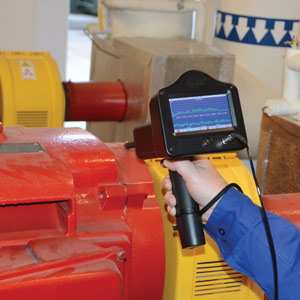Maintaining industrial equipment is a critical part of ensuring efficient and safe operations. Predictive maintenance techniques using CBM technologies are now widely used to help prevent equipment breakdowns and ensure that machinery functions as expected.
One such technique is predictive ultrasound maintenance, which involves using ultrasound technology to detect early warning signs of equipment failure. This article will examine predictive ultrasound maintenance, including what it is, how it works, and its benefits.

This article is intended for maintenance and reliability professionals, plant managers, and operations personnel responsible for ensuring industrial equipment's reliable and safe operation. It is also relevant for those in predictive maintenance programs looking to add predictive ultrasound maintenance to their toolkit.
Ultrasound Predictive Maintenance
Ultrasound predictive maintenance is a non-destructive testing technique involving ultrasound technology to detect and analyze the high-frequency sounds that machines make. These sounds often indicate problems or failures in the equipment, such as bearing wear, lubrication issues, or electrical faults. Using predictive ultrasound maintenance, maintenance technicians can identify these problems before they lead to more severe issues that could cause equipment downtime or safety hazards.
How It Works
Ultrasound predictive maintenance uses a specialized instrument called an ultrasound detector to pick up high-frequency sounds emitted by machinery. The detector converts these sounds into electrical signals that can be analyzed by a computer or other diagnostic tool. The resulting data is then used to identify any issues with the equipment and determine what maintenance tasks need to be performed to correct the problems.
 UE Systems Ultrasonic 15000 bearing spectra (Source: machinerylubrication)
UE Systems Ultrasonic 15000 bearing spectra (Source: machinerylubrication)
One of the critical benefits of predictive ultrasound maintenance is that it is a non-invasive technique that does not require any physical contact with the equipment being tested. This means technicians can test while the equipment operates without shutting it down. This makes predictive ultrasound maintenance a fast and efficient technique that can help minimize equipment downtime.
Benefits
There are many benefits to using predictive ultrasound maintenance as part of an overall predictive maintenance strategy. These include:
Early Detection of Equipment Issues
One of the primary benefits of predictive ultrasound maintenance is that it enables early detection of equipment issues. Maintenance technicians can use ultrasound technology to pick up on the high-frequency sounds emitted by machinery and identify problems before they lead to more severe issues. This can help prevent equipment downtime and reduce repair costs.
Improved Equipment Reliability
By detecting equipment issues early, ultrasound predictive maintenance can help improve equipment reliability. Equipment is less likely to experience unexpected breakdowns or failures when issues are identified and addressed promptly. This can help improve overall equipment performance and reduce the need for costly repairs.
Increased Equipment Lifespan
Another benefit of predictive ultrasound maintenance is that it can help increase the lifespan of the equipment. Maintenance technicians can prevent equipment from experiencing premature wear and tear by promptly detecting issues and addressing them. This can extend the useful life of the equipment and reduce the need for frequent replacements.
Enhanced Safety
Ultrasound predictive maintenance can also enhance safety in the workplace. By identifying potential equipment issues before they become serious problems, maintenance technicians can help prevent safety hazards from developing. This can help reduce the risk of workplace accidents and injuries.
Cost Savings
Finally, ultrasound predictive maintenance can help save money. By detecting equipment issues early, maintenance technicians can address them before they lead to more severe problems that require expensive repairs. This can help reduce repair costs and minimize equipment downtime, leading to significant cost savings over time.
Predictive Maintenance Program
To incorporate predictive ultrasound maintenance into a predictive maintenance program, organizations should follow these steps:
1. Conduct a Baseline Assessment
Conducting a baseline assessment is the first step in incorporating predictive ultrasound maintenance into a predictive maintenance program. This involves identifying the equipment to be tested, determining the testing frequency, and establishing a set of benchmarks to measure the program's effectiveness.
2. Establish Testing Procedures
Once the baseline assessment is complete, the next step is establishing testing procedures. This involves determining the equipment and areas to be tested, as well as the testing frequency and protocols. Ensuring testing procedures are standardized across all equipment and that technicians are adequately trained to conduct the testing is crucial.
3. Train Technicians
Proper technician training is essential for the successful implementation of predictive ultrasound maintenance. Technicians should be trained to use ultrasound detectors, interpret data, and identify potential equipment issues. They should also be trained on how to perform maintenance tasks based on the results of the testing.
4. Implement a Data Management System
An effective data management system is critical for predictive ultrasound maintenance. Data collected from the ultrasound detectors should be organized and stored in a centralized system that maintenance technicians and other stakeholders can access. This data can track equipment performance and identify trends that may indicate potential issues.
5. Continuously Monitor and Improve the Program
Finally, continuously monitoring and improving the ultrasound predictive maintenance program is crucial. Regular program reviews should be conducted to identify any areas for improvement. Changes to testing procedures or equipment can be made based on the data collected, aiming to optimize equipment performance and reduce costs.
Airborne Ultrasound Training
Ultrasound predictive maintenance is a valuable tool for preventing equipment breakdowns, improving equipment reliability, and enhancing safety in the workplace. Maintenance technicians can help minimize equipment downtime and reduce repair costs by detecting potential issues early and addressing them promptly. Incorporating predictive ultrasound maintenance into a program can help organizations optimize equipment performance and achieve significant cost savings over time. Predictive ultrasound maintenance can be highly effective for maintaining industrial equipment with proper planning, implementation, and ongoing monitoring.
If you want to learn more about predictive ultrasound maintenance and how to implement it effectively in your organization, consider enrolling in an airborne ultrasound training program. CRE Philippines offers a comprehensive training program to equip maintenance and reliability professionals with the knowledge and skills to implement an effective ultrasound predictive maintenance program. Contact us to learn more about our training program and how it can help your organization improve equipment reliability and reduce maintenance costs.
Source:
Rienstra, A. (n.d.). Ultrasound Detection: Predictive Maintenance for the Masses. ReliablePlant. https://www.reliableplant.com/Read/29739/ultrasound-predictive-maintenance


